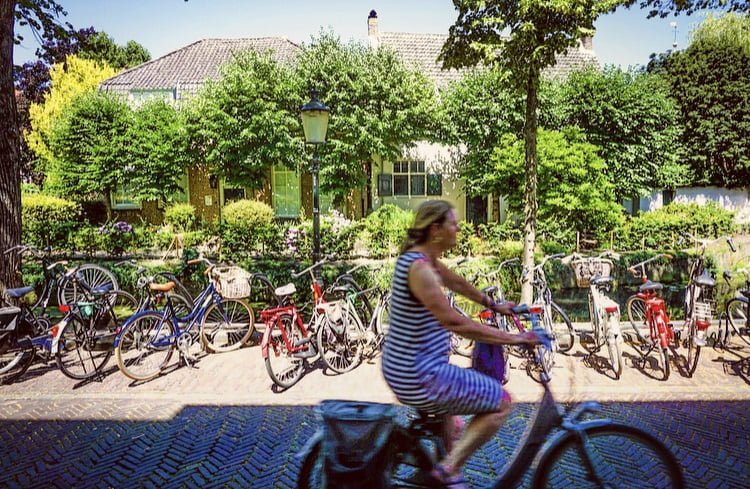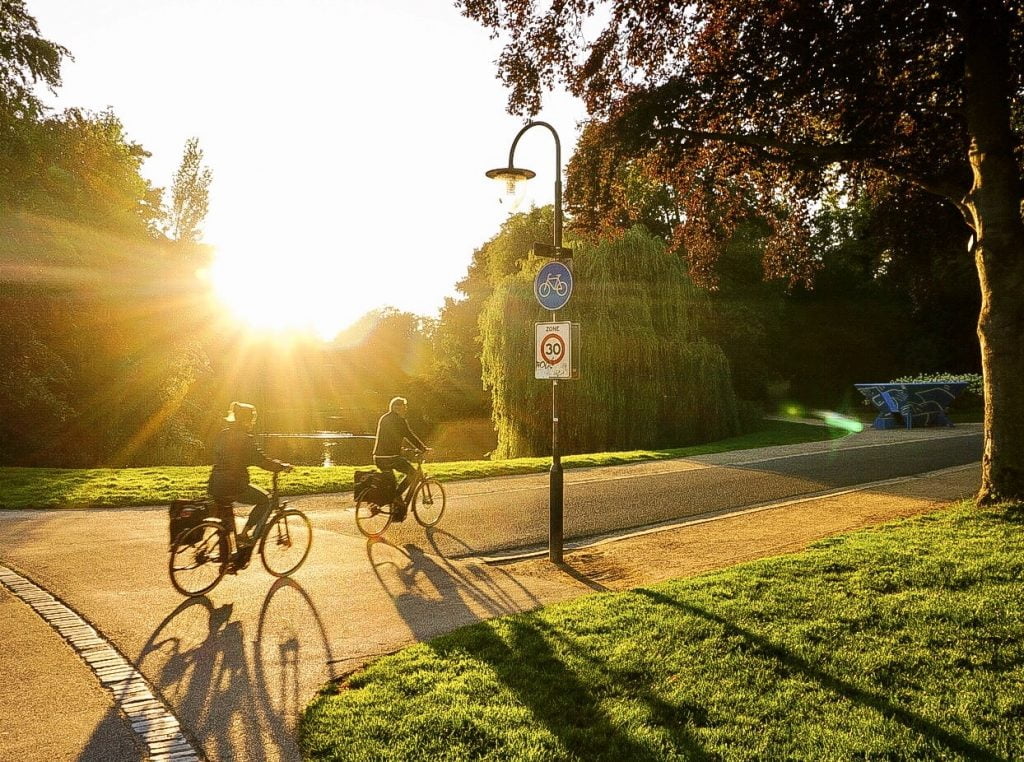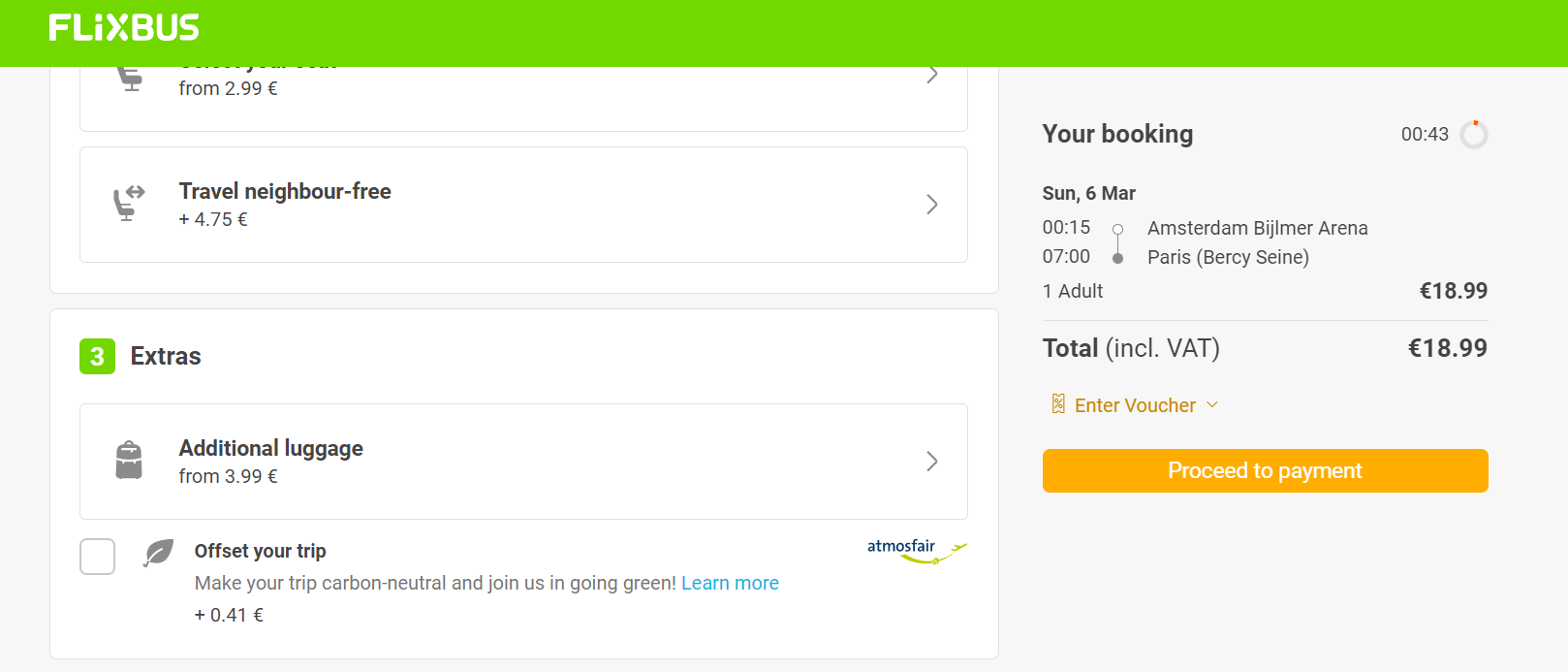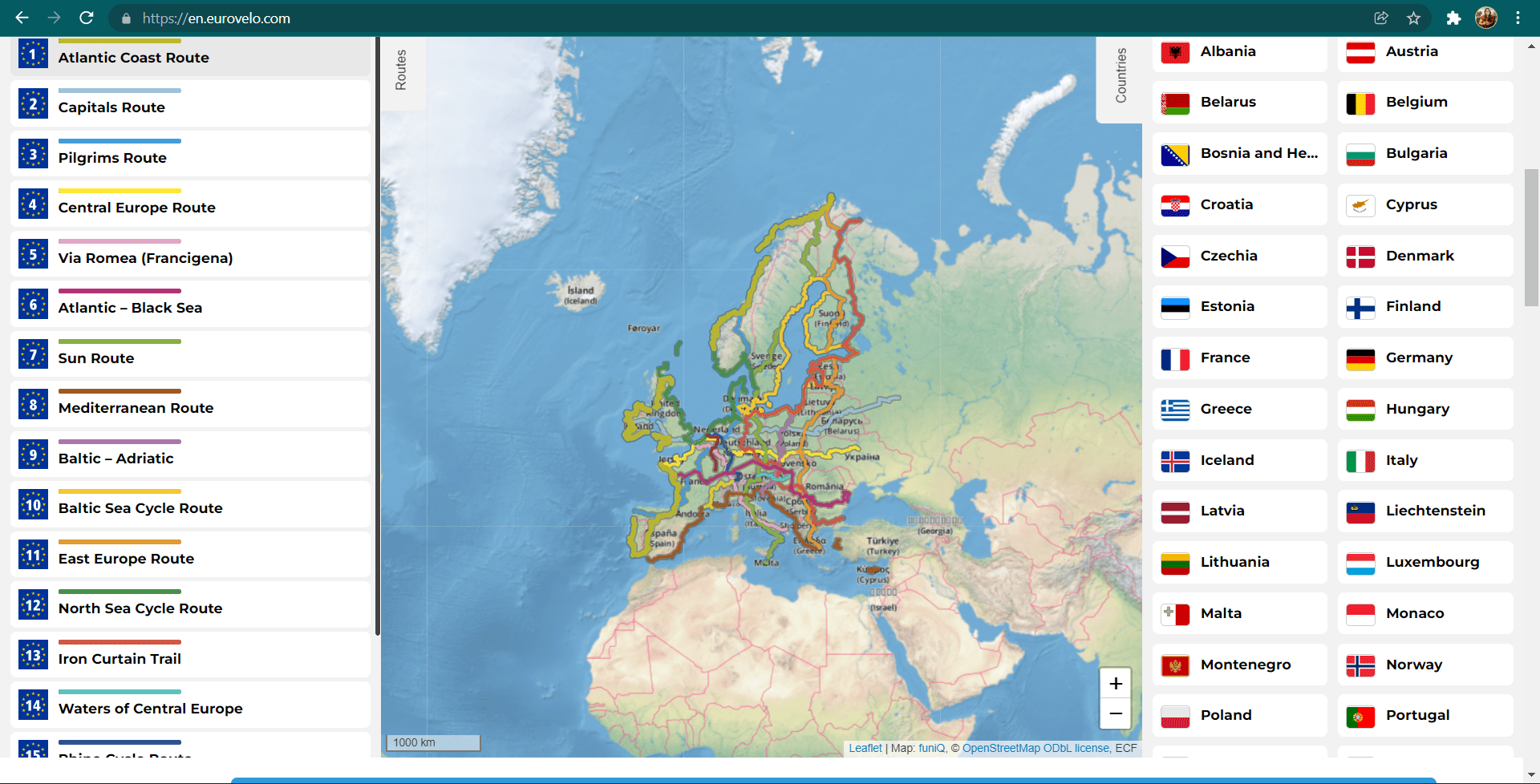Written by Kayla Ihrig from Writing From Nowhere.
All photography courtesy of Kayla Ihrig.

Introduction to a Sustainable Travel Guide To The Netherlands
The Netherlands is home to one of the busiest airports in Europe and well-recognized cultural icons. Whether you’re just exploring Amsterdam on a long stopover at Schipol or you’re planning an entire trip in the lowlands, you’re certain to have a memorable experience. Try the beer, see the nightlife, survive the bicycles and follow these sustainable travel tips for doing it all with a reduced carbon footprint.
Culture And Language To Be Aware Of
There are no cultural faux-pas to tiptoe around when making sustainable choices (such as rejecting disposables) in the Netherlands. In general, the Netherlands is a country with a lot of awareness of the climate crisis and many environmentally-friendly practices in place.
Electric cars are seen on every road, virtually every resident gets around on a bicycle and the government has many restrictions in place to reduce emissions.
The Dutch are even losing parts of their culture to the changing climate. Rest assured, you won’t offend anyone by sending back a plastic straw or asking to use your own container.

Naturally though, no country is perfect (yet) when it comes to carbon and landfill contributions. When traveling in the Netherlands, you’ll still see single-use plastic everywhere, an ironclad cultural grip on dairy and litter floating down the canals.
However, bring your own reusable products on your visit and you’re sure to get some appreciative smiles. Here’s how to refuse disposables without being rude:
To reject single-use items, say with a smile “ik heb zelf” while holding your straw, napkin, or whatever you’re using.

Pronounced phonetically “ick hep self,” this translates to “I have self.” By gesturing with your reusable product, you save yourself from needing to try to memorize specific vocabulary!
This translation isn’t the natural word choice that a Dutch person would use, but it’s the most pronounceable sentence for non-Dutch speakers! If you feel up for a challenge, give “ik heb mijn eigen” (pronounce “ick hep mine eye-hen” meaning “I have my own”) a go.
Now that you know how to reject disposables, let’s talk about what you need to pack to make it happen!
What To Pack
Like traveling anywhere in the world, you’ll need to be prepared with certain low-waste gear to prevent leaving a trail of landfill contribution in your path. This is what you’ll use most.

Reusable Utensils
Disposable plastic cutlery is already banned by the European Union. Wooden or bamboo utensils are offered in their absence, but you can do one better by packing reusable utensils instead.

If you don’t have a travel utensil kit yet, buy a set of bamboo utensils or go pick up a spoon, fork and knife from a thrift store and throw them in your bag.
Bento Box
…or any other sturdy food container.
Taking your own container to the market, grocery store or local fast food restaurants (called snack bars) will pay off handsomely. You’ll be able to reject the plastic boxes that are used everywhere when ordering any of the popular dishes of fish, chips or eierbal (a hard boiled egg with a thick seasoned outer layer).

A bento box is also perfect for packing snacks for your bus or train rides across the country or to another European highlight.
Cloth Napkin
A cloth napkin is your sidekick for so many small eco-friendly travel wins.
First and foremost, you can reject paper napkins. Even though they’re not the worst single-use offender, they’re still disposable and unnecessary.
Plus, you can take snacks to-go. Skip the bag when you grab a freshly baked Dutch snack from the local Albert Hein grocery store. When you go through the grocery store checkout with a napkin or handkerchief full of snacks, you’re all but guaranteed a smile and a “leuk!” (nice!) from the cashier.
Reducing snack packaging is always a low-waste win whether you’re at home or abroad.
An added bonus when traveling sustainably in the Netherlands is having a cloth napkin to dry your bike seat when it (inevitably) rains during your visit.

There are many more sustainable travel products worst considering on your trip to the Netherlands, but these basics will cover your most common types of landfill waste.
Planning Your Sustainable Trip In The Netherlands
With your travel essential packed, it’s time to plan your low-waste trip in the Netherlands!
Shop At The Market Over Restaurants
At the center of every Dutch city is a market. Characterized by the smell of fish, swarming seagulls (they’re bold – watch your chips) and popular Dutch delicacies, the market (called the markt) is an absolute must.
Every guide to visiting the Netherlands will tell you this, but they won’t tell you that this is a fantastic place to get cheap, fresh, local and low-waste meals.
Fill your bento box with a fresh kaasbroodjes (a popular cheese pastry), kibbeling (a fried fish delacy) or nuts, dried fruit – any of the hundreds of fresh snacks on hand.
The market can easily replace having breakfast or lunch at a restaurant. Depending on which city you’re in, there might even be a coffee stall (called a “koffie kraam”) with tables and covered seating for you to enjoy your findings.

When You Do Go Out, Choose Vegan Restaurants
Dutch culture embraces dairy more than most, but you’ll still have your pick of vegan restaurants in any major city.
Whether you’ve transitioned to completely vegan already or you’re still weighing the benefits, swamping out some of the meat and dairy on your trip will reduce your carbon footprint.
Check out these vegan guides to help you plan:
- Amsterdam
- The Hague
- Groningen
- Rotterdam
- Utrecht
- Or if your destination isn’t covered, use these general vegan survival tips for the Netherlands to help you reduce your footprint

Spend Time Outside
The Netherlands is not an “inside” country. You can’t wait for the weather to brighten up to go out and enjoy Amsterdam, Utrecht, Groningen, or wherever you’re visiting.
You might end up waiting your entire visit to the direct sunlight or blue sky. This is especially true in winter, which is characterized as being dark, cold and damp.
This somehow doesn’t phase Dutch people, and it shouldn’t stop you on your journey either.
Experience the “outsideness” that even small Dutch children are accustomed to dealing with on their way to preschool on a bicycle. You can embrace this in sustainable ways on your trip by…
- getting around on a rented bike
- choosing a walking tour
- visiting the parks as much as the museums
You’ll need to pack appropriately to make this a reality. At a minimum, bring a rain jacket or an umbrella.
To be completely Dutch-proof, pack a rain jacket AND rain pants. If you need to buy a set spontaneously while you’re visiting, duck into a HEMA (they’re everywhere) and pick up the one-size-fits-most unisex rainsuit and wear it proudly.

How To Get Around
Once you’ve reduced your landfill contribution, it’s time to reduce your trip’s carbon footprint, too.
Although renting a car is quick and easy, it’s neither the most sustainable nor the easiest way to get around. Every city center is made up of a combination of one way streets and dead ends which makes taking the car into town not for the faint of heart.

Choose from these options instead:
Local Public Transit
Since the majority of Dutch inner cities are pedestrian only, Dutch people tend to prefer public transport (which includes biking) instead of driving.
Transit cards (called an OV-kaart) are available at supermarkets, newspaper stalls, online, and at train stations. The same transit card is required for access to any mode of public transport. With one card you can get on a train, catch a bus, hop on a ferry, or grab a bike.
Trains in the Netherlands are operated by a group of local companies in addition to an overarching national company. Stations are generally located in the center of town making the train the preferred way to see the country, even for Ducth people.
With a network of electric buses (yes, electric!) that fans out from the train station, getting around is easy. Buses are convenient, clean and modern. You can expect to be able to connect to wifi or charge your phone even on your 5-minute bus ride to a museum.
Beyond the buses and trains, the Netherlands is one of the few countries in the world that has a nationwide bike sharing network. Since you can use your transit card, it is considered part of public transportation. You can purchase an annual or monthly membership, or pay per day.
If you’re just exploring during your Schiphol layover or for a weekend, a day card will be most effective. For those slow travelers who are traveling full-time while working online, a monthly membership will be the most convenient and economic choice. Finding opportunities to save money on public transit is a plus, because for all of its positive accolades, it’s not cheap.
Public transit in the Netherlands is the most convenient way to see the country but it comes at a price. In a 2019 survey, public transport in the Netherlands was listed as one of the most expensive in Europe.
Locals don’t feel this pain as much as tourists. Most Dutch companies offer a generous travel allowance to their employees, making using public transport more affordable. Some companies even offer the use of company bikes in lieu of company cars.

As for visitors who are just passing through, bite the bullet on the expensive buses and trains, or embrace the local culture on a whole new level and try your hand at cycling.
I know we’ve already touched on cycling in regards to public transit, but there’s a lot more to be said about cycling culture in this country.
Cycling
No guide to the Netherlands is complete without talking about cycling. Biking truly is a way of life in the Netherlands, as it is one of the few countries in the world that is home to more bikes than people.
Every morning, the streets are filled with parents on their bikes either going to work or dropping their kids off at school.
Younger kids are seated in kids’ seats mounted on the backs and fronts of their parent’s bikes and older children (as young as 4 years old) cycle alongside their parents. Learning to ride your bike is a rite of passage in this country.

This drips from normal Dutch life into tourism, as well. Bike rental options are plentiful and are often conveniently located at train stations, tourist hotspots etc.
Biking in the Netherlands is safe and easy, as the country has the necessary infrastructure in place. Bike lanes are everywhere, are often protected and are well maintained.
Something that has an even bigger impact is that everyone is used to sharing roads with cyclists. Cyclists don’t have to be afraid for their safety; they outnumber cars greatly.
Just make sure that you’ll read up on the rules so that YOU don’t become the hazard on the road.

International Trains
The Netherlands is a small country and as a result, it is well connected to the European rail network. Taking the train across Europe has been steadily gaining in popularity. International trains leave from the larger train stations and allow for easy trips to many other European capitals.
Although traveling to towns and cities in Germany or Belgium can be done on local trains, for destinations that are further away it is better to buy an international ticket. The German operated ICE-trains can be boarded at some of the larger train stations.
International Buses
Don’t let €1 flights seduce you into flying from one European highlight to another. I’m not exaggerating: flights in Europe are sometimes literally only €1 (plus taxes), even when there are comfortable and sustainable means of ground transportation.
Here are some planning resources that will help you see the country instead:
FlixBus
With WiFi, outlets and stops all over Europe, you could plan all of your country-to-country travel on this company alone and have a very comfortable trip.
Beyond the standard carbon reduction of choosing to bus versus fly, FlixBus also gives you the option to offset the carbon emissions from your journey at a very affordable price.
The carbon offset for a trip from Amsterdam to Paris, at 6+ hour journey, is just €0.41:

Read here to see if there are even more ways you can carbon offset your actions.
International Cycle Routes
It doesn’t get any more Dutch than a cycling holiday! You already know that the Netherlands is a methodical web of bike routes, but on a larger scale, so is much of Europe.
EuroVelo, The European Cycle Route Network
There are beautiful and incredibly well-maintained cycling routes across much of Europe. Bring your own distance bike or rent one locally for access to a huge number of highlights:

Visit EuroVelo’s website to bring on the travel daydreaming! Any of these routes would make an incredible sustainable holiday.
Sustainable Travel In The Netherlands Conclusion
When I moved to Groningen, Netherlands as an expat in 2017, many things surprised me about Dutch life. The weather shook me to my core, the seagulls could probably still beat me up and take my lunch, but the inherent sustainability to many aspects of Dutch life are breaths of fresh air.
It’s not just for locals, either. There are countless small actions that reduce your carbon footprint as you travel in the Netherlands, and these tips should make it easy. Don’t table your low-waste intentions while you’re here!
The country of the Netherlands may be small, but don’t write it off as a quickie travel destination. There’s more to see than just Amsterdam, and it’s a great place to “slow travel” while working online.
You can get lost for a good, long time trying all of the beer and bike routes that the country has to offer. Cheers to your sustainable holiday, friend! It’s going to be a blast.
About the Author
